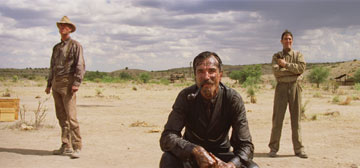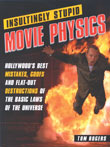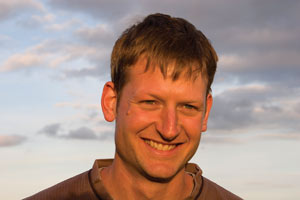|
GEOMEDIA
Check out the latest On the Web links, your connection to earth science friendly Web sites. The popular Geomedia feature is now available by topic.
MOVIES: There Will Be Blood …
BOOKS: Striking a Blow for Science: A Review of Insultingly Stupid Movie Physics
BOOKS: A Look at Earth’s Six Degrees: Our Future on a Hotter Planet
There Will Be Blood …
 © 2007 by PARAMOUNT VANTAGE, a Division of PARAMOUNT PICTURES and MIRAMAX FILM CORP. All Rights Reserved. Photo by Melinda Sue Gordon |
| An oil-streaked Daniel Plainview (Daniel Day-Lewis) |
But mostly there was oil — gurgling into the bottom of a mine shaft, shooting from the top of an oil derrick, bursting into flames, pooling on the ground and dripping down the imposing mustache of Daniel Plainview (Daniel Day-Lewis), a U.S. Geological Survey man turned oil baron in the movie There Will Be Blood.
Paul Thomas Anderson’s film, loosely based on Upton Sinclair’s 1927 novel Oil!, opens in 1898 — the start of the California oil rush. A stoic Plainview is methodically working a small silver mine. Eventually he uncovers a far richer prospect: oil. But getting oil out of the ground is dangerous business. He and his men must hoist up their discovery one precious bucket at a time. In one of the many scenes that will make safety officials cringe, the buckets fall. Plainview loses a worker and inherits a baby. He raises the child — H.W. (Dillon Freasier) — as his own, making him both his son and his partner.
But fatherhood doesn’t dampen Plainview’s ambition or soften his demeanor (“I look at people and see nothing worth liking,” he says in one scene). Monomaniacal in his quest for oil, he uses bribes, a carefully rehearsed speech and his adopted son to win over the landowners that stand between him and buried riches. He lies, he cheats and he steals. And over the next decade, he amasses a number of productive wells.
The movie follows Plainview as he transitions from a small-time wildcatter into a wealthy tycoon. Accompanying this transition is the fascinating shift in technology that took place in the early oil years, from buckets suspended precariously in a mineshaft by a makeshift system of pulleys and ropes to a long ramming pole suspended by a towering oil derrick. Incidentally, the term “derrick” comes from Thomas Derrick, who invented a better support structure for the gallows — a fitting symbol, at least in this movie.
Plainview is a fictional character, but his rags-to-riches story contains more than a kernel of truth. Anderson borrows heavily from the life of self-made oil tycoon Edward Doheny, the founder of the Pan American Petroleum and Transport Company who later became the head of the Pan American Western Petroleum Company. Both Doheny and Plainview are from Fond du Lac, Wis., both sport walrus mustaches and both end up rich. Doheny, the son of an Irish immigrant, arrived in Los Angeles in 1892 and struck oil that same year. By 1925, he was reputedly worth more than $100 million. But he fell into disgrace after federal investigators uncovered that he had given Secretary of the Interior Albert Fall $100,000 in order to secure a lease on 32,000 acres of government-owned land near Taft, Calif. Plainview falls into disgrace too, but his inevitable collapse is personal and therefore more tragic.
There Will Be Blood offers a gripping, deeply troubling performance by Daniel Day-Lewis, who won the best actor Academy Award in February for his portrayal of Plainview. In the movie, the greed and corruption evident at the birth of the petroleum industry foreshadow the greed and corruption that could accompany the industry’s eventual decline. Plainview, his face streaked with oil that glows crimson in the unholy light cast by a burning derrick, is a stark reminder of the dark side of capitalism. But he is also human, torn between his allegiance to his adopted son and his single-minded ambition. This hint of inner turmoil saves Plainview from abject villainy, but it doesn’t lead him to redemption. Instead, he walks the not-so-fine line between the two.
There Will Be Blood premiered in New York on Dec. 10, 2007, and will be available on DVD this month.
Book review
 |
Insultingly Stupid Movie Physics |
Tom Rogers’ new book Insultingly Stupid Movie Physics is not for those who prefer to suspend their disbelief. A companion to the Web site of the same name (http://intuitor.com/moviephysics/), the book carries on that site’s “noble cause” by relentlessly poking a sharp pin in Hollywood’s often overinflated scientific silliness.
Part physics textbook, part movie critique, Rogers’ grumpy-but-wry book assesses the myriad ways in which Hollywood takes liberties with basic science, gleefully pointing out both minor mistakes and wholesale violations of some of the laws scientists hold most dear. Science fiction is all well and good, but some things should be sacrosanct, Rogers argues indignantly — particularly if moviegoers are actually paying attention and therefore picking up some very wrong ideas.
The book, like the Web site, outlines Rogers’ own Movie Physics rating system, which ranges from GP (Good Physics in General) to RP (Retch). There’s also a category (NR) for movies that are not even pretending to be realistic, such as cartoons, parodies and comic book reenactments. But the book and Web site also cover somewhat different ground: The site, which has been around since 1997, offers brief synopses and quick ratings of movies, as well as scientific explanations of some of the most common mistakes, such as heroes smashing through glass windows and receiving only minor scratches — highly unlikely, physically speaking. (In fact, to make this even appear possible, some filmmakers have actually used “panes” made of sugar in such window-breaking scenes, he notes.) The book, however, goes into significantly more detail about why specific movies got the ratings they did, and exactly how they got it wrong.
Many of the basic laws of physics, Rogers writes, are like Barbie dolls, rather than immutable laws — they’re useful as models and to get a general idea of how something will look, while avoiding too much complexity. Although generally applicable, there are still gray areas, and therefore, bending some physics rules (such as incorporating time travel, which is still very gray) in the name of artistic license may earn a movie only a minor infraction.
However, some laws are simply sacred, he says — and the most important of these is the first law of thermodynamics (conservation of energy as well as mass, as shown by Einstein’s theory of relativity, or E=mc2). Violators of this law often include movies based on comics, like The Hulk (the hero somehow increases in mass without scooping up any nearby matter) and Spider-Man (where does all of that web stuff materialize from, anyway?).
Nearly as important is the second law of thermodynamics, which essentially means that the basic plot of The Matrix — in which intelligent machines use humans’ bioelectrical energy to power their cities — would never work, because such an energy conversion would be much too inefficient. (Rogers notes that Hollywood would never make such basic mistakes about the rules of, say, football.) The book also covers movie violations of Newton’s first, second and third laws of motion (covering inertia, the relationship of acceleration to mass and force, and equal and opposite actions/reactions), as well as gravity and many other basic principles of classical physics (but doesn’t get into quantum physics). How integral the bad physics is to the story — whether it’s a major plot point or a less crucial scene — also affects a movie’s rating.
With its attention to detail, the book may be less appealing than the Web site to a casual moviegoer who just wants a quick GP or RP rating before choosing a movie to rent. In fact, with its multiple insets, boxes and diagrams explaining scientific laws, the book could be a basic physics primer, offering students a fun way to learn and visualize these concepts. Still, although Rogers suggests that the more casual reader can just skip over these boxed lessons, the text itself is bursting with detailed explanations and mathematical calculations. Scientists may cheer and nod in solidarity as he lays out the details, but nonscientists are more likely to glaze over and flip to the end.
For those who do flip ahead, however, the book’s final chapter effectively sums up its message, providing Rogers’ opinion of the worst physics movies of all time. The absolute worst (the “pinnacle of badness”) is many scientists’ favorite punching bag, The Core, which would take an entire book in and of itself to really take apart, he says. But a few other movies are almost equally insultingly bad, such as The Matrix trilogy, The Day After Tomorrow and the most recent War of the Worlds.
For moviegoers who airily brush off his physics nitpicking with “it’s only a movie,” Rogers has this to say in his introduction: “Read no further. It will spoil your fun.” But anyone who has ever groaned upon seeing a scientific whopper on screen is likely to find that Rogers’ book is its own form of entertainment.
Links:
Insultingly Stupid Movie Physics Web site
Geotimes: On the Web review of the Insulting Web site
Past Geotimes movie reviews:
"Watching The Core: A movie review," Geotimes, April 2003
"Earthquakes, climate change and reel disasters," Geotimes, September 2004
A Look at Earth’s Six Degrees: Our Future on a Hotter Planet
 Courtesy of Mark Lynas |
| British journalist and author Mark Lynas |
Six Degrees Could Change the World
This spring, National Geographic Channel has been airing Six Degrees Could Change the World, a documentary-type program based on Mark Lynas’ book, Six Degrees: Our Future on a Hotter Planet. The program walks viewers through the hypothetical changes that may be expected around the world as Earth warms from 1 degree Celsius up to 6 degrees Celsius over the next 100 years.
It starts with smaller changes, such as coral bleaching and desertification and moves into everything from water supply issues to armed conflicts over resources to complete inundation of coastal areas and islands by rising seas. National Geographic has also posted a fairly detailed Web site (channel.nationalgeographic.com/channel/sixdegrees/) to accompany the program. It allows visitors to click on the temperature changes to explore what happens at each level, as well as lists different steps humans can take to mitigate some of these changes. The Web site and documentary are both more alarmist than Lynas’ book, but are worth checking out if you don’t have the time to read the book.
A Look at Earth’s Six Degrees
The Intergovernmental Panel on Climate Change (IPCC) predicted in its Fourth Assessment Report that average global temperatures will rise between approximately 1 and 6 degrees Celsius during this century. This climate change will clearly impact our planet, but what will specific places look like as Earth warms degree by degree?
To find out, British journalist and author Mark Lynas sifted through tens of thousands of modeling and paleoclimate studies published in the peer-reviewed scientific literature. He organized each paper by individual degrees. In Six Degrees: Our Future on a Hotter Planet, Lynas describes the various scenarios that materialized as he synthesized the individual predictions into six complete pictures, each peering into a progressively warmer future. In his conclusion, Lynas outlines the steps needed to keep his book from becoming reality.
Six Degrees provides a sobering glimpse into our possible future. Without being alarmist, the book paints a vivid picture that delivers a message to the lay audience that — until now — had been buried in the technical literature.
Lynas spoke with freelance writer Nicole Branan about Six Degrees and the impression it left on the author.
NB: What prompted you to write Six Degrees?
ML: I had a general sense that there was a lack of understanding about what would happen in specific terms and in specific places as Earth warms up. There was a lot of information flying around about melting ice caps and doomed polar bears and so on, but no one was very specific about what temperature changes implied what particular impact. That’s of course crucial information because we need to know how rapidly and abruptly we need to reduce our emissions in order to avoid which temperature change and in order to avoid which impact.
NB: Do you think that the public discussion about climate change focuses too little on the concrete implications of the findings that are published in the scientific literature?
ML: I wouldn’t say that. I think it’s a very difficult subject for the media to handle because there tend to be two competing approaches. One is that all is lost and we are essentially doomed and the other centers around the idea that climate change is not as bad as we thought.
In Six Degrees I focus specifically on what is really scientifically incontestable because it’s published in the leading peer-reviewed journals and is supported by countless other papers.
NB: When you assembled the various possible future scenarios, was there anything that surprised you about the pictures that emerged?
ML: I think the main impression that I was left with was the limited time that we have left in order to avoid the worst impacts, particularly regarding the positive feedbacks. If you look at the climate history over millions of years, you see that it operated essentially through a cascade of feedbacks. These tend to reinforce the direction of change and I wanted to bring that out to demonstrate that if we warm the climate past, say 2 degrees, then it’s increasingly difficult to keep it below 3 degrees, which might then push it up to 4 degrees and so on. The danger escalates as you warm the climate more and more.
NB: Your book is the synthesis of a large body of peer-reviewed scientific literature. This approach is very similar to the one that the IPCC uses for its reports. How does Six Degrees differ from these reports?
ML: Obviously, the IPCC reports are the work of many different authors all of whom have a very high standing within their field and I come to this as a layperson and a journalist. So, if you are looking for the most authoritative scientific information you should of course use the IPCC report as your first point of reference. I suppose it’s a difference in terms of who the audience is and how easily readers can assimilate this kind of information. For example, you don’t take the IPCC’s Working Group I report to bed at night but you could do that with Six Degrees.
NB: Did the experience of writing Six Degrees cause you to make changes in your own lifestyle?
ML: I have been working on climate change for quite a few years now and I have certainly been aware in doing this work that you need to put your own house in order before making pronouncements about how other people should live their lives. For me, that has meant reducing my carbon footprint to pretty much one-fifth of what the national average is in the United Kingdom. While I do fly occasionally — I went to the Bali climate change summit last year for example — I don’t fly for holidays or personal reasons. We don’t own a car, we go by bike and by train, we heat our house with a wood stove rather than using gas and all our electricity comes from renewable energy sources. But I certainly admit that it’s difficult to be completely pure about these kinds of things.
Links:
channel.nationalgeographic.com/channel/sixdegrees/

 Subscribe
Subscribe


